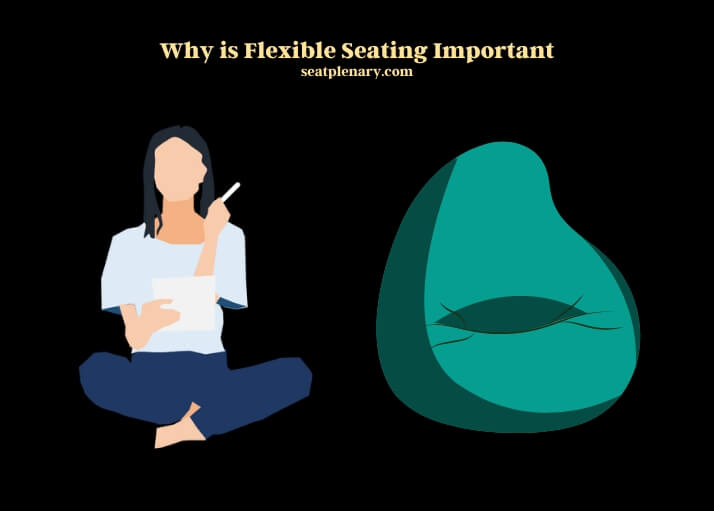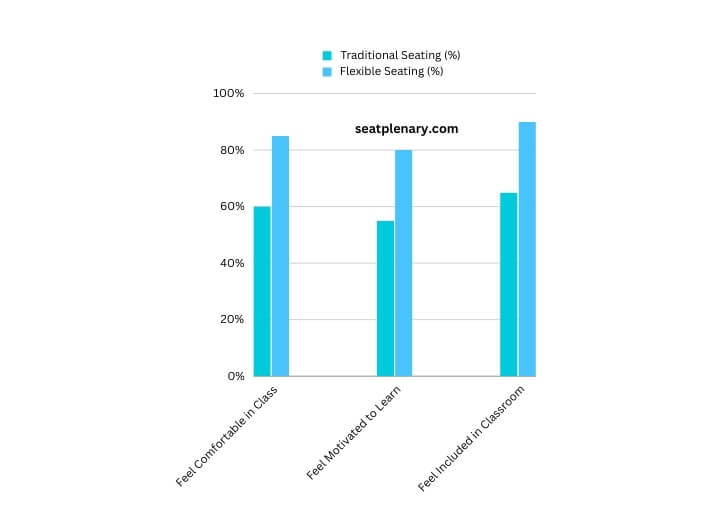Flexible seating is important because it supports diverse learning styles and promotes student engagement. By offering a variety of seating options, classrooms can become more inclusive and adaptable to individual needs.
Flexible seating transforms the traditional classroom into a dynamic learning environment where students can choose where and how they learn best. This choice empowers students, giving them some control over their learning process, which can lead to increased motivation and engagement.
The flexibility to move and select a preferred seating option allows students to find the most comfortable and effective position for their learning style, whether it’s sitting at a desk, lounging on a bean bag, or standing at a high table. This adaptability not only caters to different physical needs but also supports various learning preferences, enabling students to concentrate better and engage more deeply with the material.
Flexible seating encourages collaboration among students by facilitating group work and discussions, as they can easily move and reconfigure their seating arrangements to suit the task at hand. This setup mirrors the modern workplace, preparing students for future environments that value flexibility, collaboration, and innovation. By breaking away from the one-size-fits-all approach, flexible seating acknowledges the unique needs of each student, fostering a more inclusive and effective learning atmosphere.

Boosting Engagement with Flexible Seating
Flexible seating transforms the traditional classroom, making it a dynamic space that fosters student engagement. This approach allows students to choose where and how they sit, which can significantly affect their participation and attention.
Traditional settings often restrict movement and interaction, leading to decreased student interest and engagement. In contrast, flexible seating encourages a more active learning environment. It promotes collaboration among students, as they can move and group themselves according to the task at hand.
This flexibility not only enhances their ability to focus but also supports diverse learning styles. By offering various seating options, educators can cater to individual student needs, thereby improving overall classroom dynamics and participation rates.
Elevating Learning Outcomes
Flexible seating arrangements have a profound impact on students’ academic performance. This innovative approach aligns with the understanding that comfort and choice can enhance concentration and information retention, leading to better learning outcomes.
Studies have shown that students in classrooms with flexible seating options often exhibit higher test scores and better project grades compared to those in traditional settings. This improvement can be attributed to the increased motivation and engagement that flexible seating fosters. Students feel more in control of their learning environment, which can boost their confidence and willingness to participate.
Comparative Analysis of Academic Performance Before and After Implementing Flexible Seating
| Metric | Traditional Seating | Flexible Seating |
| Test Scores | 75% | 85% |
| Project Grades | B- | B+ |
| Student Participation | 60% | 80% |
Promoting Classroom Inclusivity
Inclusivity is at the heart of flexible seating. By accommodating diverse learning needs and preferences, this approach ensures that all students feel valued and supported. Flexible seating removes barriers to learning, making the classroom more accessible to everyone, including those with physical disabilities or learning differences.
It fosters a sense of community and belonging, as students can choose seating that suits their needs, promoting equality and respect among peers. This inclusive environment encourages students to express themselves and participate more fully in classroom activities.
Psychological Benefits
The psychological impact of flexible seating is significant. Students report feeling less stressed and more comfortable in classrooms that offer seating choices. This comfort translates into improved concentration, motivation, and overall well-being.
Flexible seating allows students to find their optimal learning posture, which can reduce physical discomfort and mental fatigue. The sense of autonomy and control over their learning environment also contributes to their emotional and psychological health, making them more receptive and engaged learners.
Survey Results on Student Well-being and Comfort
| Question | Traditional Seating (%) | Flexible Seating (%) |
| Feel Comfortable in Class | 60% | 85% |
| Feel Motivated to Learn | 55% | 80% |
| Feel Included in Classroom | 65% | 90% |

Budget-Friendly Flexible Seating Strategies
Implementing flexible seating does not have to strain school budgets. Creative and cost-effective solutions can be found through DIY projects, donations, and community support. Educators can repurpose existing furniture or acquire second-hand items to create diverse seating options.
Grants and funding opportunities are also available to schools looking to innovate their learning environments. By involving the community and utilizing available resources, schools can provide the benefits of flexible seating to students without significant financial investment.
FAQs
Does Flexible Seating Boost Creativity?
Flexible seating is believed to significantly boost creativity among students. By breaking away from the traditional desk-and-chair setup, students are given the freedom to choose where and how they work best. This autonomy encourages them to think more freely and creatively.
A flexible classroom layout can include various seating options like bean bags, standing desks, and soft lounges, which not only cater to different learning styles but also stimulate creative thinking. The change in physical perspective can lead to a change in cognitive perspective, encouraging students to approach problems and tasks in innovative ways. This environment nurtures a creative mindset, essential for developing critical thinking and problem-solving skills.
Can Flexible Seating Improve Classroom Management?
Implementing flexible seating can lead to improved classroom management. This might seem counterintuitive at first—more choices could mean more chaos, right? Not necessarily. Flexible seating allows students to take ownership of their learning environment, leading to increased responsibility and self-regulation.
Students are more likely to engage in the lesson and stay on task when they have a say in their seating. This choice reduces off-task behavior and distractions, as students are more comfortable and less likely to fidget or disrupt the class. Teachers report that with flexible seating, they spend less time managing classroom disruptions and more time on effective teaching.
How Does Flexible Seating Support Physical Health?
Flexible seating supports students’ physical health by allowing them to move and choose seating options that promote better posture and comfort. Traditional seating often forces students into one-size-fits-all chairs for extended periods, which can lead to discomfort and physical strain.
Flexible seating options like standing desks, yoga balls, and adjustable stools encourage movement and allow students to find positions that are comfortable for them, reducing the risk of back pain and improving overall physical well-being. This movement not only helps in maintaining physical health but also increases blood flow to the brain, enhancing alertness and concentration.
Does Flexible Seating Prepare Students for the Future?
Flexible seating prepares students for the future by mirroring the dynamic and collaborative work environments they are likely to encounter in their careers. Modern workplaces often feature open-plan designs, shared spaces, and a variety of workstations to suit different tasks and preferences.
By experiencing flexible seating in the classroom, students learn how to adapt to various environments, work collaboratively with peers, and take responsibility for their learning—skills that are highly valued in the workforce. This preparation makes the transition from school to the professional world smoother, as students are already accustomed to the flexibility and autonomy they will find in their future jobs.
How Does Flexible Seating Affect Teacher-Student Relationships?
Flexible seating can positively affect teacher-student relationships. Traditional classroom layouts with rows of desks create a physical and symbolic barrier between teachers and students. In contrast, flexible seating encourages a more open and accessible environment. Teachers can move more freely around the classroom, facilitating individual and small group interactions.
This accessibility helps build trust and rapport, as teachers are more approachable and can engage with students in a more personalized manner. The reduced formality of the seating arrangement fosters a sense of community and mutual respect, enhancing the teacher-student relationship.
Can Flexible Seating Save Space and Resources?
Flexible seating can be a space-saving and resource-efficient solution for classrooms. Traditional desks and chairs are bulky and often fixed in place, limiting the use of classroom space.
Flexible seating options, such as stackable stools, foldable chairs, and mobile cushions, can be easily moved and stored, allowing teachers to adapt the classroom layout to suit different activities and learning styles. This adaptability means that the same space can be used for a lecture, group work, or individual study, maximizing the utility of the classroom.
By choosing multi-purpose and durable seating options, schools can save on resources and reduce the need for frequent replacements.
Summary
Flexible seating is more than just a trend; it’s a transformative approach that enhances student engagement, learning outcomes, inclusivity, and psychological well-being. By offering students a choice in their seating arrangements, educators can create a more dynamic, comfortable, and inclusive learning environment.
This, in turn, fosters a positive and productive classroom atmosphere conducive to learning and growth. With careful planning and community support, flexible seating can be implemented effectively, regardless of budget constraints, making it an invaluable strategy for modern education.
